What is material recycling?
Producing recycled plastic by cleaning, crushing, and kneading waste plastic
There are three ways to recycle waste plastic:
- Chemical recycling
- Material recycling
- Thermal recycling
Material recycling is a method of producing pellets (recycled plastic) by cleaning, crushing, and molding waste plastic. When plastic is made from petroleum, CO2 is emitted during the process from drilling for oil to synthesis of plastic. In contrast, low CO2 is emitted when recycled plastic is obtained via material recycling, and material recycling is highly effective at reducing CO2 emissions.

There are three forms of material recycling:
1. Upgraded recycling (upcycling)
This is a way to add new value after recycling and to reuse the material to provide greater functionality. This form of recycling can expand the extent to which recycled plastic can be used.
2. Horizontal recycling
This is the most mainstream form of material recycling and is a way to reuse materials for the same purpose as their initial use. Recycling old PET bottles into PET bottles is a familiar example.
3. Cascade recycling
This is a way to reuse the material to produce materials with less stringent specifications. PET bottles are often turned into fiber for clothing.

Konica Minolta is involved in upgraded recycling and horizontal recycling. Upgraded recycling is used to produce exterior materials for multifunction printers (MFPs) from PET bottles and water bottles. Horizontal recycling is used to make toner bottles for MFPs from milk bottles and paper trays for MFPs from the interior components of gaming machines.

Recycled plastic technologies that Konica Minolta has accumulated over more than a decade
Konica Minolta has been using the recycled plastic obtained via material recycling in its MFPs for over a decade. In the process, we have developed the following technologies:
- High purification technology
- Upgraded recycling technology
- Molding technology
High purification technology
High purification technology is a technology that thoroughly removes foreign matter and impurities attached to waste plastic. By developing this technology in-house, Konica Minolta has turned recycled plastic made completely from waste plastic into a practical reality.
As an example, Konica Minolta’s toner bottles use a PCR material* made from used milk bottles, and the PCR material is manufactured using our high purification technology. If the PCR material is manufactured with stains or foreign matter still on the milk bottle, it will have diminished physical properties compared to petroleum-based plastic and its quality will vary more widely. However, use of the high purification technology developed by Konica Minolta allows the same level of physical properties as petroleum-based plastic to be maintained.
*Post-consumer recycled material, i.e., recycled plastic made from plastic used and disposed of by general consumers.
The steps to make a PCR material using high purification technology are as follows:
1. Sorting
The collected waste plastic includes bottles other than milk bottles and caps, so it is sorted.
2. Crushing
The labels on the surface of the milk bottles are removed to an extent and converted into flakes.
3. Cleaning
Flakes of milk bottles are cleaned to remove grime and milk stains.
4. Color sorting
Flakes cleaned by washing still include a small amount of colored flakes from caps, so sorting by color ensures consistent quality.
5. Kneading
The flakes are melted at high temperatures and kneaded to produce pellets of the PCR material.


Upgraded recycling technology
In order to use recycled plastic in more products, a high level of performance has to be achieved in terms of strength and flame retardance. As an example, exterior components contain the most plastic in an MFP. These components must be strong enough to withstand strong impacts and be flame-retardant to ensure the safety of customers who use the product. Konica Minolta has developed its own upgraded recycling technology based on polymer alloy technology that was fostered during toner development. As a result, recycled plastic with dramatically improved strength and flame retardance compared to waste plastic can now be produced. This has enabled the use of recycled plastic in components that account for 88% of the surface area of MFPs.

Utilization of recycled plastic in MFPs is 35%, and components account for 88% of the surface area. Upgraded recycling technology has added flame retardance and increased the impact strength 10-fold. In addition, we use recycled plastic we developed for the plastic components of our MFPs in order to reduce CO2 emissions during product manufacturing. In FY2022, we recycled approximately 5,000 tons of waste plastic and we reduced our CO2 emissions by approximately 7,000 tons.
Material recycling is a form of recycling that helps to reduce our environmental impact and to create a recycling-oriented society by reducing CO2 emissions and the consumption of natural resources. However, there were concerns about a decline in quality, and this technology was not amenable for components that require high performance. Upgraded recycling technology eliminates these shortcomings of material recycling and should greatly boost our contribution to the environment.
Molding technology
Konica Minolta molds recycled plastic using methods known as “blow molding” and “injection molding.”
・Blow molding
Toner bottles are consumables. When these bottles are manufactured, recycled plastic is fed in from the mouth of the extruder and melted at high temperatures. Next, a tube of molten plastic called a parison is formed and then clamped in the toner bottle mold. With the parison clamped in the mold, air is blown inside the parison to inflate it. The plastic takes the shape of the mold, resulting in a toner bottle.
・Injection molding
Recycled plastic pellets in a hopper are fed into a barrel below. Heating elements around the barrel melt the plastic into a liquid, and a screw forces the liquid out of the barrel. The molten recycled plastic is extruded through a nozzle and poured into a mold to form the desired component. At this time, the mold is cold, so the liquid recycled plastic hardens quickly. The resulting component is pushed out by an ejector pin and removed from the mold.
Molding large components with a number of ribs (protrusions) is difficult, but Konica Minolta can mold a wide range of components from small to large.


Steps in the production of recycled plastic
1. Recovery of raw materials
2. Breakdown and sorting
3. Crushing
4. Cleaning
5. Specific gravity sorting
6. Kneading
7. Matelier is complete

Various types of waste materials are collected from around the world for use as raw materials. Waste plastics are separated and sorted, or machines are disassembled and their pieces are sorted. Next, the plastic is crushed into flakes and then cleaned. Flakes that have been washed clean are then subjected to specific gravity sorting to remove heavy metals or color sorting, depending on the type of raw material.
The steps thus far are known as “preprocessing.” A mixture of different types of plastics or stains on the recovered raw materials can greatly contribute to variability or a decline in the quality of recycled plastic, so preprocessing is extremely important.
After specific gravity sorting and color sorting, kneading is done. At this time, additives such as flame retardants and pigments are sometimes added to ensure physical properties, achieve the desired color, or add new functionality.
The quality of plastic deteriorates in high temperature environments due to thermal decomposition and hydrolysis (decomposition by moisture). Thus, kneading technology is required to minimize the effects of thermal history in order to ensure quality.
Inquiries about our recycled plastic
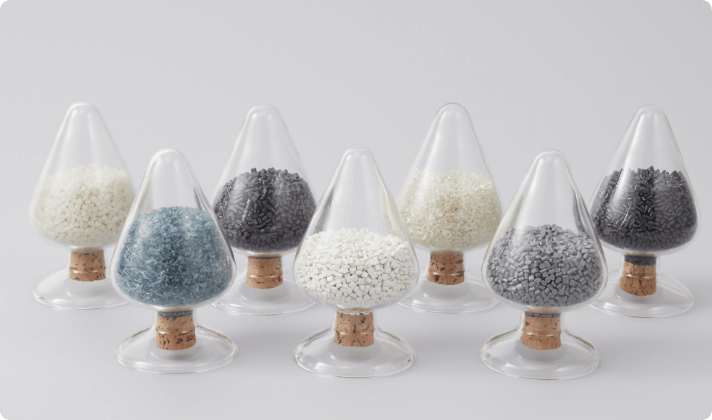
Products
Matelier utilizes waste materials that have a short usage period and relatively little deterioration. For example, milk bottles, water bottles, PET bottles, and other bottles that are discarded as soon as they are finished drinking are used as raw materials. In addition, CDs and DVDs used indoors or in cars, and amusement machines that are used in air-conditioned rooms and whose models are changed every 3 to 5 years are also utilized.
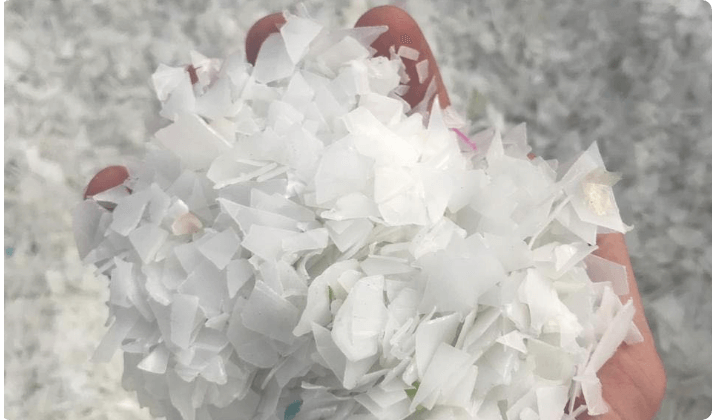
Technology
The recycled plastic developed by Konica Minolta is used in the housing of MFPs, which require highly functional materials, through high-purity and upgrade recycling technologies. These technologies have the potential to expand the use of waste plastics and contribute to the realization of a sustainable, recycling-oriented society by reducing environmental impact.
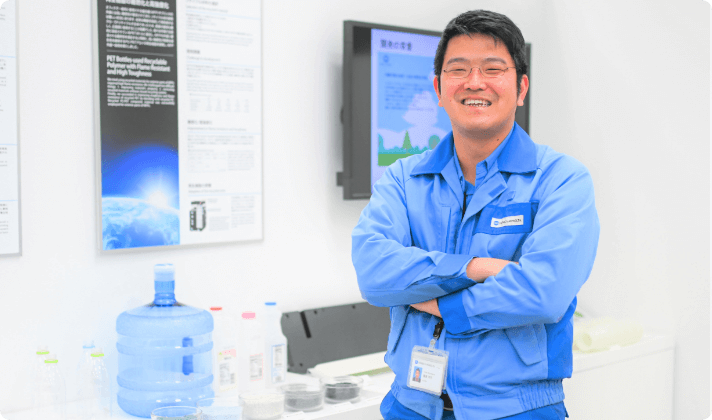
Message
Recycled plastics must offer the same or better quality, cost, and supply as petroleum-derived virgin plastics, as well as high environmental performance, making the formulation design extremely challenging. We achieved our goal by designing the entire process, including the production process, while making full use of material design/analysis/evaluation technology, one of our core technologies.
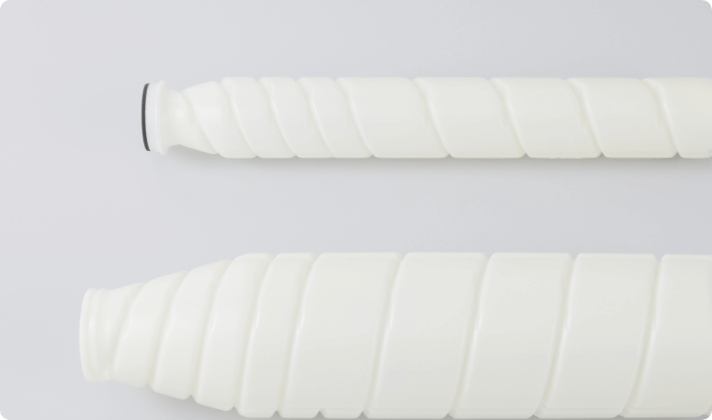
Case
Konica Minolta has been accumulating recycled plastic technology for more than 10 years. Konica Minolta has been using recycled plastic obtained through material recycling in its MFPs for more than 10 years.
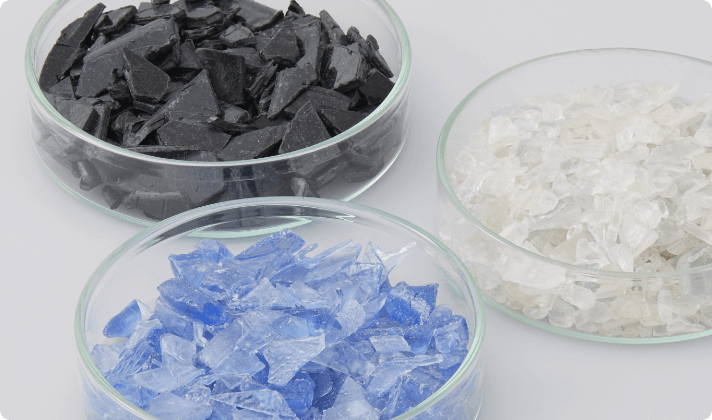
FAQ
Konica Minolta utilizes raw materials for PCR materials that have a fast replacement cycle and relatively little degradation, so there is little variation in physical properties, ensuring that the properties are almost the same as those of virgin materials.
